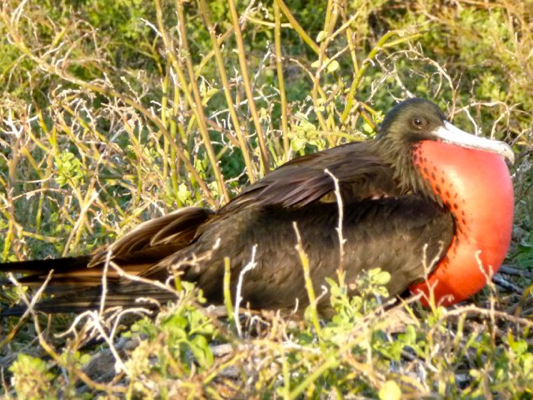Cruising Galápagos

II: Cruising the Galápagos Islands
a: Itinerary.
A map of the Galapagos Islands with the itinerary of our tour is shown on the map below. We did not go to any of the islands east of Genovesa, so I have left them out to increase readability of the map below. The days are spent exploring the islands and the associated wildlife; there is also time for snorkeling or paddling around in a kayak. At night the boat goes to the next destination, so not to lose any time, as we try to sleep rocked and sometimes forcibly shaken by the waves.

You will note that Baltra airport is on South Seymour, an island north of Santa Cruz, and that Puerto Ayora is on the south of Santa Cruz. There is a ferry between these two islands where the fare is $0.80 per passenger. (The U.S. dollar is the standard currency in Ecuador). A taxi from the ferry terminal in the north of Santa Cruz will take you to Puerto Ayora over the highlands in about 45 minutes. The fare is $18.
b: Day 1, December 7, 2012. North Seymour.
Our flight from Quito was late and we were hustled from Baltra Airport to the Tip Top IV, which was moored in the adjacent harbor. The boat immediately left for North Seymour island close by for our first walk. We had a wet landing, which meant that the panga (Zodiac) would get on a beach and we had to jump off in a few inches of water to walk up the beach. The walk itself was not that easy, because these islands are volcanic in nature, and we had to navigate on very uneven solidified volcanic lava.

But it was an amazing experience to be able to view the wildlife unafraid from very close by. The first time it takes your breath away. The seals and sea lions actually believe they have the right of way, if their path cross ours.
left: A young seal trying to suckle at his mother, completely unperturbed by the spectators. Park rules do not allow humans to come closer than 2 meters to the animals.
The Galapagos has many frigate birds; you see them everywhere. You have the Great Frigate bird and the Magnificent Frigate bird. These birds are large, with a wing span comparable to that of an albatross, and they are often referred to as the vultures of the sea.
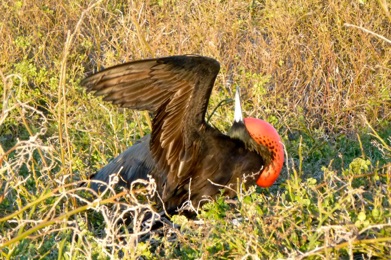
We were lucky to see a Magnificent Frigate bird puffing out his scarlet pouch just a few yards away. This is his call for a female to join him. (see picture above) He was actually a bit further away from the large group of other frigate birds nearby. Frigate birds have claws and they need a perch to sit on; they have trouble walking on the ground.
right: A female frigate bird had just answered the mating call of the plaintive Lothario by swooping down on the male. She is the one with the uplifted wing in the foreground.
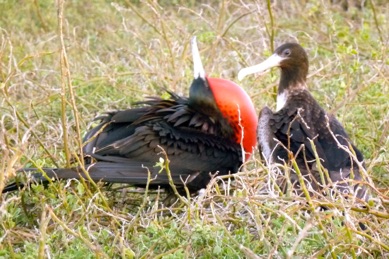
This frigate bird was on some low-lying bushes close to the ground, and we didn’t think this Don Juan would attract any female. We were wrong; soon a female swooped down and joined him.
left: Now they are happily together and you can immediately see who is the boss.

right: A pair of mating swallow-tailed gulls in the dusk.
Dinner on board was made of good ingredients, but the cook wasn’t quite up to the quality of a Cordon Blue chef. What could have been an excellent repast was just good.
c: Day 2, December 8, 2012. Genovesa
We left North Seymour Island at night and motored to Bahia Darwin (Darwin Bay) in Genovesa (see map), a 56 miles traverse through somewhat choppy seas.
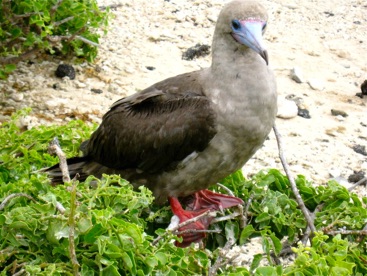
Our morning walk followed a wet landing at Darwin Bay. There were flightless cormorants, as well as red-footed boobies and immature frigate birds. And marine iguanas were everywhere.
left: A red-footed boobie
Then we went back to the boat to get dressed and to came back to the beach to snorkel. The water temperature was 68 - 70 ℉, a little bit on the cool side, and a wet suit is comfortable to have. Wet suits were available by ordering in advance for rent. It was $35 per suit for the whole trip and worth it.
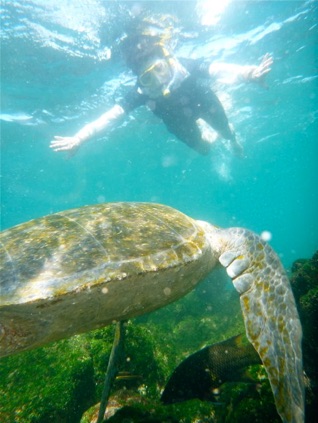
right: Norma swimming with a Black turtle
In the afternoon we had a tour in the pangas of the surrounding striated rocks. My knowledge of plate tectonics is minimal, but the rocky cliffs do look nice. In and below the rocks sea lions were frolicking around, as well as the Galapagos fur seals, marine iguanas, red crabs, boobies, and more other stuff. It gets overwhelming to keep up what you see.
There are three species of boobies in the Galapagos: (a) the blue-footed boobies. They are the most prevalent. They have blue feet (obviously) and their head is covered with brown-black rug-like feathers. (b) the red-footed boobies. They have bright-red feet; their neck, snow white when they are young, becomes covered by a soot-like color as they mature. Their beaks are blue. (c) the Nascar or masked booby. There is actually a small difference between these two species, but they are often lumped together. The masked boobies have grey-colored feet, a beautiful white neck, a yellow beak, and black feathers around their eyes, giving the impression of a mask.
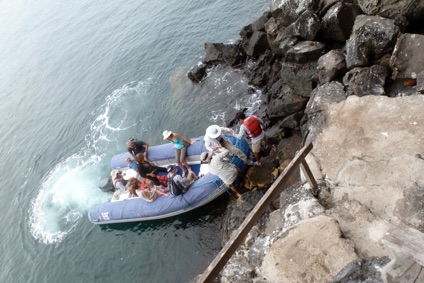
The rocky cliffs looked tall and forbidding, but somewhere, a steep path had been chiseled; these are the Prince Phillip’s Steps, which we climbed to get on the plateau, some 40-50 feet above sea level.
left: The Prince Phillip’s Steps landing.
Up there were a surprisingly large number of female masked boobies nesting out in the open, sitting on 1 - 3 eggs. They were obviously not worried about predators. The frigate bird may pose a danger to their eggs, but they cannot maneuver well on flat ground.

The frigate bird and the boobies live in harmony with each other, but the frigate bird may harass a boobie if there is food involved.
right: On the shrub are 3 frigate birds, the middle one is immature. Walking in front is a pair of masked boobies. Frigate birds cannot walk on the flat ground.
The nest of the masked booby female is ringed with an almost perfect circle of white excrement. The female stands up and squirts her poop in one direction, turns a bit around and squirts more poop. Keep on doing this and you get the perfect circle, because they know how they can very reproducibly squirt their poop a certain distance. Humans are woefully deficient in this art.
below: A female masked boobie hatching 2 eggs surrounded by a perfect circle of white excrement.
What is this circle for. Apparently this is the boundary where the fledgeling hatchling is not supposed to cross for safety reasons.
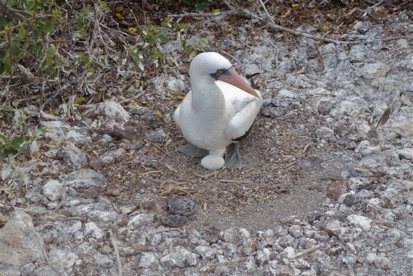
In the slowly failing light we admired a a yellow crowned night heron, and red-billed tropic birds with their long tails and red beaks. And there is an abundance of the Galapagos mocking bird, one the of the 13 species of finches on the islands. The ground finch is the largest of the species.
Before we boarded our ship we circled a local fishing vessel nearby, being accompanied by a large number of frigate birds circling around. The crew was cleaning the fish they caught, which were then salted and stored away. The birds were waiting for the fish offal.
The fishermen are only allowed to fish with line and hook. The rockfish they were cleaning were maybe 4-8 lbs each. We were told that in the olden days the fish they caught were substantially larger, but overfishing has depleted the bigger fish.
d: Day 3, December 9, 2012. Santiago
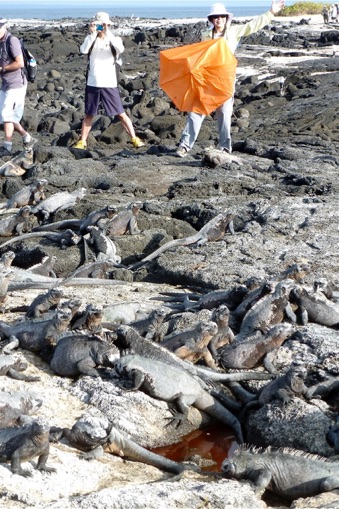
right: There were thousands of marine iguanas on the lava rocks.
These iguanas are descended from the land iguanas in South America and probably came here accidentally by drifting on some floating vegetation or driftwood. In the Galapagos, they had to adopt to a strictly vegetarian marine diet. They are the only marine iguanas in the world. Their tails are very long, flat in shape to assist in swimming, and about half the length of the whole body.
The iguanas appear to have a good life. There is sufficient food, and they can spend most of their time warming themselves on the black lava rocks. Their skin color mimics those of the rocks, an ancient camouflage against predators and also to absorb more heat from the sun. Their main diet is the Ulva, a chlorophyl-rich algae, which they usually obtain from the growths on the underwater rocks. Because of this diet, their salt intake is much higher than what they need. An interesting sight is these iguanas blowing a strong spray of salt water through the nostrils into the air, up to a foot high. This is to remove excess salt from their system.
There is another reason why they spend so much time in the sun. David Attenborough has shown with infrared cameras that the body temperatures of these animals go down precipitously when diving for food in the cold waters. So when they get out of the water they are chilled to the bone and need to heat up before their bodies can process the food.
Fur seals dotted the landscape, as well as sea lions. To the untrained eyes, these two species look quite similar. But seals cannot “walk” on their flippers; the sea lions do. Seals do not have external ears; sea lions do. Seals cannot raise themselves on their front flippers, sea lions can. Seals swim with their posterior flippers; sea lions with their front flippers.

And everywhere are the red crabs.
left: Two of the many red Sally Lightfoot crabs on the islands.
Our walk ended at the grottos, an area where you can see underwater grottos and pools with clear blue water. There was even a natural bridge crossing over these pools. The picture above Chapter 1 was taken in this area.
Walking back was inland over an easy sandy road.
In the afternoon we left for a walk on Espumilla, a brown sandy beach on Santiago Island. On the way there there were turtles mating in the water. Nothing like a free salacious show as the zodiacs circled the huffing and puffing animals. And just like in a real peep show, there is a lot of thrashing around but not much concrete to see. But people still spend good money to be in the audience.
The male is smaller than the female, and as usual, the male is on top. Copulation is hard work and the female has to keep straining not to drown if the male gets too amorous. And around the mating couple are more male turtles expectantly and impatiently waiting their turn. Multiple coitus is desirable to develop a healthy gene pool for the 300 or so eggs an average female lies. These females lay eggs up to 5 times per year. The picture below shows two marine turtles mating in the water.
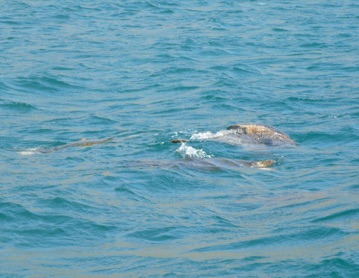
right: Marine turtles mating in the water.
On the beach were a number of marine turtles and their nests in the sand of the upper parts of the beach. It takes a turtle hours to walk up the beach, preferably at high tide, to get to the desirable places.
The picture below shows a marine turtle going back to the water. She probably came back from laying her eggs further up the beach. Still, it sometimes takes them up to six hours to find a good place, which is dry, even at high tide, but not too far from the water.
They then dig a round hole where they fit, and then another smaller hole, where they deposit their eggs. This again takes many hours. The eggs are covered by a mucous secretion for protection, and then covered by sand. By the time the female is finished it is many hours later. If it is 12 hours, they can catch the next high tide.

left: A marine turtle going back to the water. In the back are two pelicans enjoying the surf
As we walking there, we saw somebody jogging the length of the beach, about 2-3 miles long. He went back and fro some 3 times. He was the captain of our ship and he was trying to set a good example for us. Nobody followed him.
In the afternoon we had a tour of the northern part of the island from our ship. looking at the high, striated cliffs. We passed Buccaneer’s Cove, now completely deserted. Here is where in olden times buccaneers had a settlement, from where they raided the gold and silver-laden galleons destined for Spain. These ships were actually heading to Panama, where the cargo was transferred on donkeys to cross the isthmus, before being reloaded on the Pacific Coast on a galleon for Spain. For good measure they also raided the ships sailing south from Panama loaded with silver coins to pay the Spanish expeditionary forces.
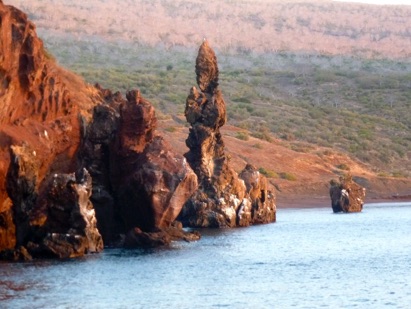
right: The rock called “The Widow” with behind it Buccaneer’s Cove
e: Day 4, December 10, 2012. Isabela and Fernandina
Our yacht sailed all night to arrive at Punta Vicente Roca of Isabela Island, a journey of around 86 miles. Vicente Roca used to be the president of Ecuador; he is also known for his efforts to sell the Galapagos Islands, unsuccessfully, it appears. The coast was rocky with high cliffs and there was no place to land, so in the morning the pangas just motored around to enjoy the view and the wildlife. There were flightless cormorants around the coast. Because they cannot fly, the area where they can fish is limited and their numbers are declining. There was a huge cave, the Tagus Cove, with a lot of fish in the water.
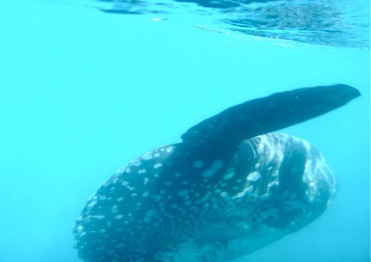
Somewhat of the coast we saw several sunfish swimming around; a funny hunk of a round fish with a fin on the top. There seems to be also a fin at the bottom and it looked as if nature had some problems giving the fish an acceptable fishy face. These were large fish with a diameter of close to one foot. Looks like the fish has a lot of meat.
left: An underwater picture of a sunfish.
The driver of our panga claims they are not good to eat. Another crew member insisted on the opposite. Judging from the assured tone of their pronouncements, I guess neither of them had tried this fish. This is how arguments start and grow.
I decided to check and I found out that this was a very bony fish, which makes eating it difficult. On the other hand, people who know how to get the meat out, say it tastes as good as lobster. It is considered a delicacy in some countries, such as Japan, Korea, and Taiwan.

right: The fin of a sunfish sticking out of the water.
This fish, also known as the Mola mola, which is “millstone” in Latin, is actually a very unusual creature. Their main diet is jellyfish, which is fabulous since a lot of us, including me, don’t like those stinging creatures. They do eat a lot of jellyfish, because 100 gr of jellyfish is only worth 4 calories, and yet a Mola in captivity was able to gain 800 lbs in just 14 months.
Molas can also grow to become very large fish, some of them up to 5,000 lbs, and all on a diet of jellyfish. They hold the world record of being the largest bony fish in the oceans. So the fish we saw are actually still quite small. The female Mola can carry a huge number of eggs. A 4’ specimen was at one time found to have 300 million eggs in her ovaries.
For a very entertaining description of the Mola, go to the presentation of Tierney Thys. She is a marine biologist and a National Geographic Explorer.
We went back to the ship to don our swimming gear and went back to the cave for some snorkeling. Lots of turtles were swimming around. A “ball” of smaller fish was moving around with penguins swimming and feeding on the fish. A couple of sea lions were harassing the penguins. They coexist but the sea lions always like to be rambunctious.
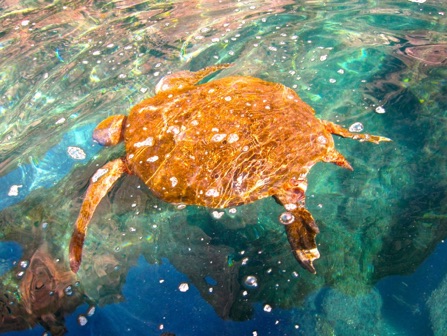
left: A turtle in the water. The reflecting light makes for an interesting pattern
In the afternoon we sailed south to Fernandina Island, where we made a wet landing and walked all the way to Punta Espinoza over mostly lava rocks and sandy beaches. Here were lots and lots of marine iguanas, sea lions, marine turtles and large red crabs.

A Galapagos hawk was sitting regally on a promontory looking in the distance and occasionally contemptuously at us.
right: A Galapagos hawk surveying the environment. A pelican in the far distance.
And another hawk, in the bushes with a
banded leg, was feasting on the placenta of a sea lion.
For the first time, we saw another group on the same island we were walking on. It was the mv Eclipse, a 48-passenger ship belonging to Ocean Adventures.
f: Day 5, December 11, 2012. Isabela
At night we sailed through the Bolivar Canal to Bahia Urbana, where we made a wet landing on Urbina Bay (Bahia Urbina). On the nice, short hike, we saw a few large Galapagos land turtles (different from the marine species), and land iguanas, which are also quite different from the marine iguanas. You will see a picture of a land iguana a little bit further below. The marine iguanas have a flat tail to assist them in swimming. The land iguana’s tails are triangular in cross-section and quite hefty. They also have nicer colorations and they live in burrows in the ground.

The Galapagos also has a poisoned apple, so this particular fruit is not specific to Paradise. In either case bad things will happen if you eat it. A surprise was finding a blooming cotton plant. The Galapagos cotton plant is quite similar to the standard cotton bush, but it has a beautiful purple flower. The finches use this cotton to make the inside of their nests soft.
left: A blooming cotton plant.
In the afternoon our boat sailed south to Bahia Elizabeth, where we took the pangas to explore the mangroves around the shores. There were more marine turtles busily mating in the water. I suppose there is not much more in the way of entertainment for them.
And on the coast, before we glided into the mangroves, there were rocks with lots of blue boobies and flightless cormorants on them.
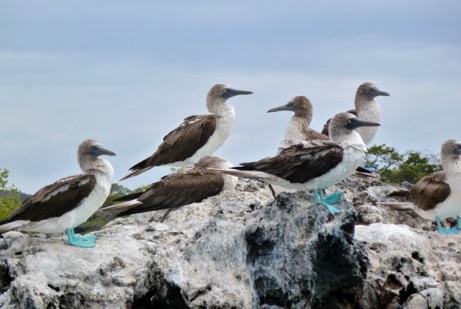
right: Blue boobies on a rock. Note their bright blue feet. No, I didn’t color them with Photoshop.
The zodiac motors were turned off as we slowly and almost noiselessly glided through the mostly red mangroves. There were flightless cormorants; a penguin perched on a rock intently looking at the water below. And the lava heron, a quiet and unassuming bird.
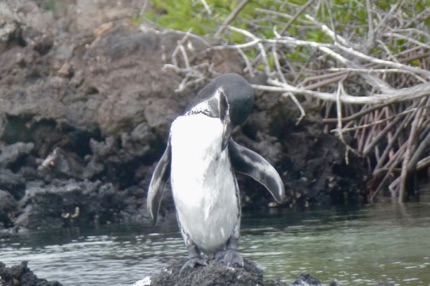
Left: A penguin watching for a snack to swim by.
These penguins are the second smallest in the world; only the blue fairy penguins in Tasmania are smaller.
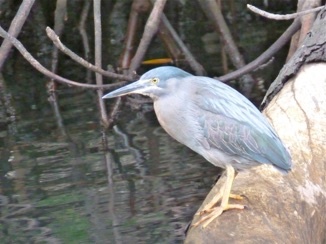
A lava heron, a small bluish bird, stood silently on a small promontory. She too was watching for a morsel to swim by, either a small crab or a fish, which she can quickly spear.
right: A lava heron also watching for a snack to swim by.
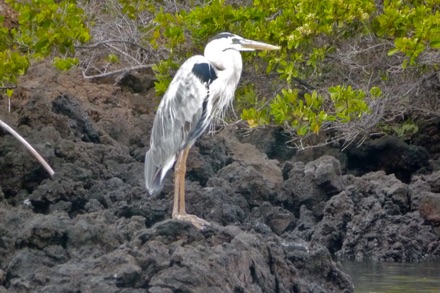
On another rock a Great Blue heron was standing apparently looking disconsolately in the distance.
left: But this Great Blue heron was also looking for fish in the water.
Everywhere were turtles swimming in the water. This is such a beautiful area and difficult to comprehend that at one time some 80 % of these mangrove had been destroyed to make commercial shrimp ponds.

right: A colorful land iguana. Note the long heavy tail with a triangular cross-section. .
These land iguanas grows up to a length of 3-5 feet. They are primarily herbivores, eating the prickly pear cactus, fruits, flowers, pads, and even spines. Sometimes they will also eat insects and carrion. Their estimated lifespan is 50-60 years.

left: The red-billed tropicbird in full flight, one of the most beautiful birds in the archipelago. Picture taken by Sima Gottesfeld.
The graceful tropicbird has a tail, which is as long as the body. They feed on fish and on squid, but they are considered poor swimmers.
g: Day 6, December 12, 2012. Puerto Villamil
At night we motored some 85 miles through some rough water around the southwestern cape of the island to arrive in Puerto Villamil on the south coast of Isabela in the morning. It was foggy and there was a slight drizzle; it did not look very promising. The landing was on floating piers of the small island Las Tintoretas.
The pangas took us at low tide to the pier of Puerto Villamil. On the dock we had to avoid stepping on marine iguanas, as well as their excrements, which were all over the place. Our bus was waiting for us.
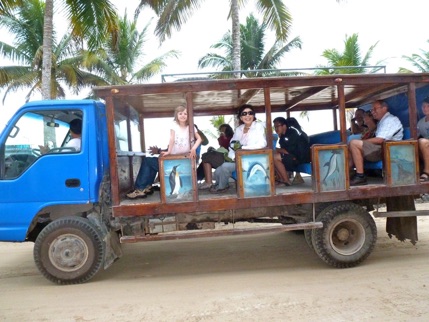
This was a covered, otherwise open-air converted truck with several parallel benches on the back.
left: The bus for our transport.
Our destination was the rim of the Sierra Negra volcano, and the bus drove us through rural landscape and some settlements slowly up the flanks of the mountain. It was getting cold sitting in the back of the bus. After about an hour we came to a place at around 900 m elevation. It was cold and it was drizzling. We could have gone back but we had gone so far, so we plodded ahead. We still had to do a rather stiff hike for 30-40 minutes to climb another 200 meters up to get to the rim of the caldera. It was misty and the landscape was completely whitened out.
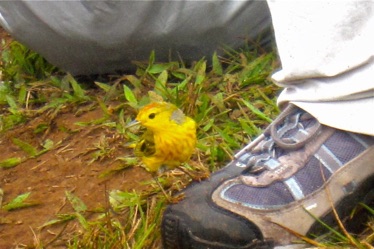
right: Only a small very friendly yellow warbler finch kept us company. He was quite unafraid and we had to be careful not to step on him.
But after sitting disconsolately for several minutes, suddenly the mist lifted for a few minutes. We could see the astounding 7 km diameter caldera, presumably the second-largest in the world. The huge crater is actually a combination of several calderas. There was time for some pictures, before the mist came back and closed everything down again.
below: On the rim of the huge caldera of Sierra Negra volcano. The caldera is 7 kms across. This looks like a regular forlorn landscape, but it is actually a huge caldera. You can barely see the opposite side.
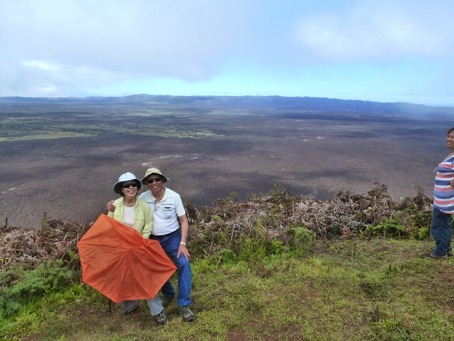
When we were back in port, we saw customs carefully and thoroughly checking the luggage of a group of young tourists leaving town on a cruise ship. I wonder whether they were checking that no artifacts had been taken along.
We came back to the ship for lunch and then, after a short rest, we were back in town.
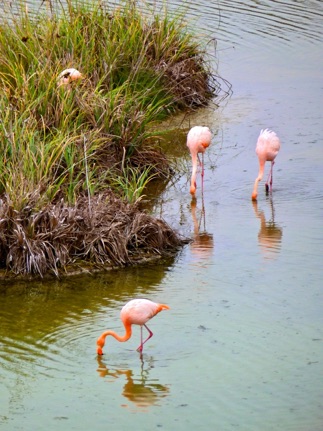
Our bus first stopped by a large pond, bordered by high cliffs. This was where an old quarry used to be, covered with either salt or brackish water (I didn’t climb down to taste the water), and in there was a group of pink flamingoes, ostensibly dancing around. What they were doing was walking in a circle and shoveling the mud into the middle of the circle at the same time, where they stick their beak in. Their beaks have a mesh to strain the food from the mud, and that was what they were doing.
Animals are always looking for food. Except maybe the marine iguanas, who seem to make sunbathing their only goal in life.
right: These are real pink flamingos, not the plastic variety so well beloved in Florida.
After this interlude our trusty bus took us to the “Arnaldo Tupiza” turtle breeding center. Here we saw our first huge turtles. Yes, they were in enclosures; and some of them were huge.
In this center on Isabela Island, hundreds of collected eggs of the endangered turtle species are hatched to ensure a higher rate of success. The eggs are collected from the wild, but mostly from breeding pairs.
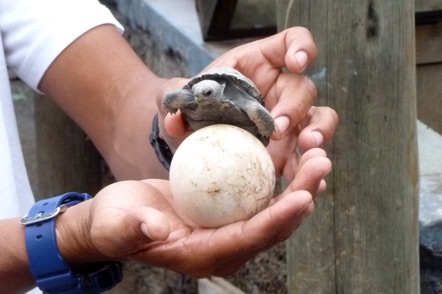
left: A 12-day old turtle and a turtle egg. These eggs are large.
The ensuing turtles are bred for about 5 years before they are released in the wild. A small electronic tag is inserted in one of their rear legs for tracking purposes. Not all turtles are released. Many are held for breeding purposes. That is why some of the specimens are so old and big.
We are talking about land turtles here, which are different than the marine turtles. Some of these land turtles become very large as they reach 100 and more years of age. They are much larger than the marine turtles. In this center five species, all from Isabela, are bred. The ratio of males to females bred here is roughly 1:4. The female is more important to the survival of the species.
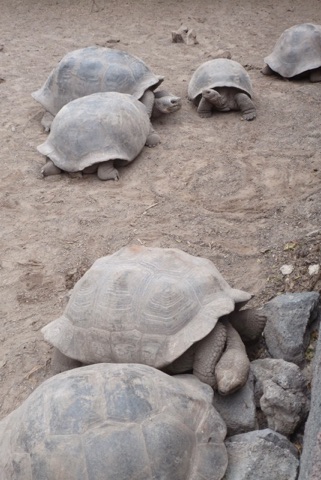
right: Large land turtles bred in the Arnaldo Tupiza turtle breeding center. There are around 350 turtles in this facility.
There were 13 land turtle species in the Galapagos. Two have become extinct. Lonesome George, who died in June 2012, was the last of a species, so there are now only 10 species left. Five of them are found on Isabela.
One of the species bred here, the one from Cinco Cerros, looks different because their shell looks flattened instead of rounded. They are called the “aplastadas”. At one time they were threatened to extinction because their nests were attacked by a certain species of ants. They have now have a healthy stock of these turtles.
The Breeding Center is nicely laid out, with a lot of opportunities to take pictures of these turtles in their holding pens. You see turtles over a hundred years ago, and also newly hatched turtlelettes, as well as the unhatched eggs. The place is laid out as a park, with pleasant winding paths and gardens with many native plants, such as the manzanillo, mesquite, prickly pear, etc. There is a building with good informative explanatory displays of the work in the Center. At the end is a box for donations to keep up the work. Please give.
Later that afternoon the bus took us to the beach adjacent to the small town. There is a small, beautiful church where the stained glass windows show the specific Galapagos wildlife, such as the blue-footed boobie, the frigate bird, the penguin, etc.
At the end of the day we gravitated to a bar on the beach where the drink in vogue was the coco loco. This was a cooled coconut, freshly chopped open to give access to the juices, to which is added a thimbleful of white rum. $5 each. Good for the mouth, the soul, the local economy and the conversation.
The meat of the coconut, if the fruit is not too old, makes for a very tasty snack. So Fabrizio had the coconuts chopped open, from which he scraped the meat into a big plastic bag to take to his crew as a treat.
As we were waiting for our Zodiacs on the dock of the town, he bumped into a very comely young colleague, who was leading another tour. The plastic bag ended up in her purse.
h: Day 7: December 13, 2012, Floreana
The night was spent usefully by crossing over to Floreana, where the morning was misty with a slight drizzle. Many more cruise boats were dotting the bay, because Floreana is a popular stopping place for most cruises before the passengers disembark the next day in Puerto Ayora.
Black beach, southwest of Post Office Bay, has the lurid history most often discussed by visitors. In 1929, Dr. Friedrich Ritter, a dentist, arrived here with his mistress, Dore Strauch, where they lived as Robinson Crusoe did for some three years. Being a dentist, he knew that it would be disastrous if they had tooth problems during their stay so, before their departure, he had all of his and her teeth pulled out and he had dentures made. The story goes that they lost one denture, so they had to share the other one.
The Wittmers came in 1932. They were German farmers from Bayern. Later the same year a woman, who claimed to be Baroness Von Wagner de Bousquet, came to the same island with her two lovers, Lorenz and Philipson. Soon she claimed the island as her own, and her autocratic and selfish behavior created much bitterness in the small community.
One day in 1935, the Baroness and Philipson disappeared without a trace, leaving all their belongings intact in their abode. The Wittmers claim they had come by in the morning to tell them they were leaving for Tahiti. Lorenz was found a few months later mummified on a deserted beach of Marchena Island, quite a distance to the north (see map). There is a lot of speculation of what actually happened, which keeps the rumor mills happily churning away.
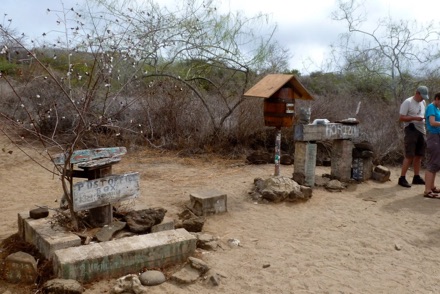
So that morning we left our mother ship in our pangas for a wet landing on Post Office Bay. A number of fur seals on the beach were snoozing away not much caring for our presence. Here too were the red Sally Lightfoot crabs busily scurrying around.
left: The mailbox in Floreana.
Some 50 yards inland is a mailbox, installed by a man named Hathaway in 1793. The original mailbox was probably in the pile on the left; the current one on the right certainly looks younger than 200 years old. You drop your mail in, correctly addressed but unstamped, and hope the cards and letters will sooner or later reach their destination. This is not an official Ecuadorian mailbox, but it is something which has been apparently successfully in operation for these 200+ years.
In practice most of the mail will reach the recipient in 2-3 weeks or so, which is better than the 4-5 weeks projected for the regular mail. Why?. Well, if you are a traveler, and most of the people coming to this desolate mailbox are obviously travelers, you drop in your mail, then you rifle through the stack of mail. If you see an addressee close to where you live or where you will be soon, you take the mail along. You can then deliver the mail personally or affix a stamp for local delivery by your friendly local post office staff. It is now a fun system, but the concept has been in operation for some time, as we also saw in Iceland. We sent a postcard to ourselves and it arrived in three weeks. But it is probably not a good idea to commit information about your Swiss bank accounts to this mail.

It was a short walk to the beach on the other side of the island at Punta Cormorán. Turtle tracks on the beach from the water to the higher regions where they have laid their eggs show very recent activity by these mammals. Some of these tracks suggest that these turtles may have spent up to 6 hours just to get to the area where they could lay their eggs. And another six hours to get back.
right: Turtle tracks from the nest where she had laid her eggs back to the sea.
On our way back we saw more than the usual number of finches. They start becoming very active at this time of the year. This is the start of the rainy season and the influx of their preferred food supply, the insects. This is the time when they start courting; then they build a nest together from dried twigs and vegetation in the shape of a large ostrich egg with a small entrance away from the weather side (2 weeks). These nests are about 6 - 9” tall, depending on the species. The inside of some of the nests is comfortably lined with wool from the cotton plant, which conveniently starts opening their buds at this time of the year. Two weeks to incubate the eggs, and another 4 weeks to hatch the eggs, grow the youngsters, and then teach their newborn to fly.
These finches were derived from just a few birds blown in from Costa Rica, based on the closest resembling species in Ste Lucie Island in the West Indies. This happened centuries ago. They were probably seed-eaters but in the Islands there were many other available food sources with no competition, so now 13 species of finches and 2 species of warbler finches have developed from this one species to avail themselves of these opportunities. For comparison, there are 436 species of finches in the world. There are also no hummingbirds or parrots in the Galapagos Islands.
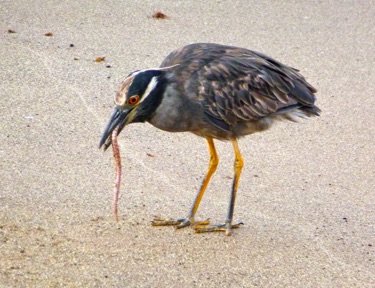
left: A Yellow Crowned Night Heron trying to eat something she can barely swallow..Just like what a lot of us always try to do.
Later that day, there was deep water snorkeling off Champion Point. Michael made a video with our recently acquired underwater camera of a sea lion frolicking around him.

The waters are also bountiful in species we don’t usually see. On the right is a picture of a school of surgeon fish, taken with our recently acquired Lumix underwater camera.
right: My brother-in-law, Guy, an international aquarium fish expert, tells me they are called Tangs, or Yellowtail Surgeon fish, because they have a very sharp appendage near their tails that they can flick out if they are threatened. Most Tangs advertise that sharp "knife" in some way to keep potential predators away. These particular tangs call attention to their weapon by the zebra pattern on the body where the tail is attached. These tangs are probably too large as aquarium fish.
We then motored around to look while some of us when kayaking in the sea kayaks.
below: A colony off female sea lions and their pups.
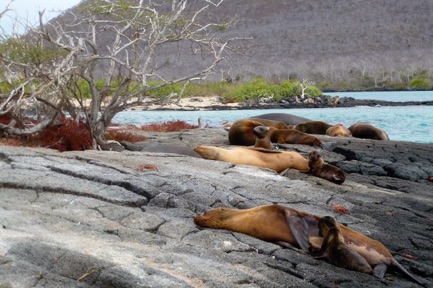
There was a colony of female sea lions and pups; the master sea lion was swimming around somewhere protecting his harem.
If you are a male sea lion, you better stay away. Unless you are big, strong, and ready for a fight.
At the end of the morning, some of us took the sea kayaks for a spin.
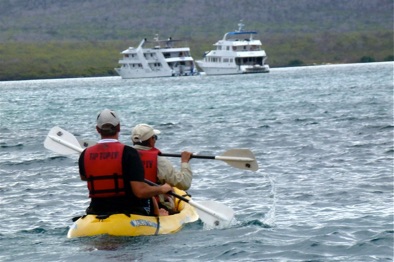
right: And here is Daniel, the big guy in the back, and Hok training for the sea kayak championships in the coming Brazil Olympics
After lunch, the boat lifted anchor and sailed north to Santa Cruz. The captain invited us to look at the bridge. It is a lot of work to handle this ship because it doesn’t have an autopilot and somebody always has to be at the wheel. But the ship does have a lot of navigational stuff as well as provisions to handle emergencies. They don’t want to lose any tourist passengers. Bad for business.
We arrived in Puerto Ayora at dusk. It was still drizzly outside.
Friday, December 7, 2012
